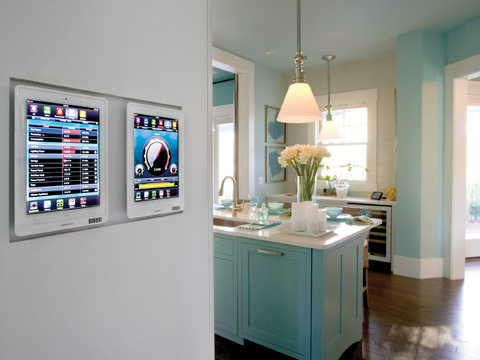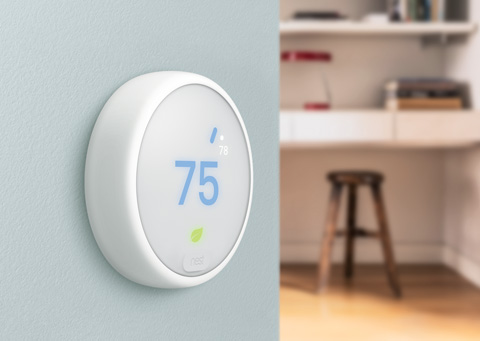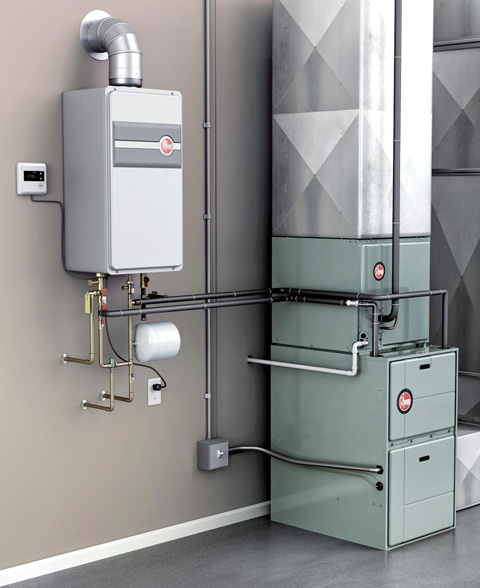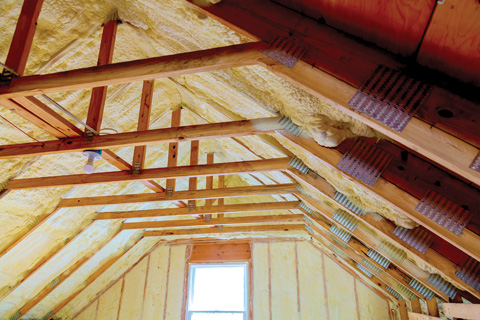Saving energy is often a top concern of homeowners, whether driven by a desire to lower their utility expenses or tread lightly on the earth. Each year we see new technologies that help make saving energy easier than ever, but there are some tried-and-true methods to consider as well.
Built-In Efficiency
The most important thing you can do to reduce energy consumption is ensure that you are building a home with the least amount of air leakage as possible. That begins with the design of the home and the materials you use for the structure, including insulation. As you go through the design process, make sure your log home producer understands that energy efficiency is a concern for you and discuss the options they offer.
Log homes are by nature very efficient, because of the stability and thermal mass of solid log walls. In fact, a 2010 Log Homes Council study found that log homes are 2.5-15 percent more efficient than conventional homes of the same size. Golden Eagle Log and Timber Homes in Wisconsin Rapids, Wisconsin, offers half- and full-log systems with a variety of insulation choices. A customer that opts for a half-log home with spray-foam insulation will have a home that is air tight with a very high “R factor” —meaning the amount of heat that transfers in during the summer and out during the winter is minimized, keeping your home comfortable year-round.
“We do an energy audit for every home that we sell before we do our final engineering to make sure it passes for the region we build in,” says Jay Parmeter, who owns Golden Eagle Log and Timber Homes along with his brother Tod. This ensures that the whole home’s energy efficiency is accounted for—boosting attic insulation to counter the effect of large windows, for example.

producthealth.com
Invest in Insulation
We all know that warm air rises so it’s no surprise that investing in the insulation in your roof is money well spent. “Warm air is constantly trying to escape through your roof,” says Allen Halcomb, president of MossCreek in Knoxville, Tennessee. “The battle is in your roof—that’s your best money spent.”
The type of insulation you need to use will depend on the climate, from fiberglass batting in temperate regions to spray foam or hard insulation in more extreme climates. “The return on investment is also relative to the environment you are in,” says Halcomb. “Here in Tennessee spending money on insulation reaches a diminishing return, but if you live in Minnesota or south Florida you would experience much quicker returns on your investment.”

Nest Thermostat E Lifestyle 5
Appliances and Utilities
Appliances account for more than 20 percent of our electricity bills, but they are an area where it is easy to rack up savings. New refrigerators, dishwashers and clothes washers and dryers use half as much energy as the appliances made just 15 years ago. Look for EnergyStar® ratings when you select your appliances to be sure you’re bringing home the most efficient models—EnergyStar® certified models use about 15 percent less energy than standard models.
“Looking at the mechanical systems, the number one thing you could do to improve energy efficiency would be improving the quality of your heating and air conditioning system,” says Halcomb. “There are many types of new compressors out there that are multi speed—the fan slows to a crawl, but it’s always working at a minimal level.” The price differential for a multi-speed compressor is minimal, so it’s a worthwhile investment, especially if you live in an area with a more extreme climate.
Your water heater is another easy way to save energy. “We are doing almost 50 percent tankless hot water heaters,” says Halcomb. “The benefit is if you are entertaining a lot of people there’s an endless supply of hot water.” On the flip side, if your home is a vacation property and not occupied for large stretches of time, you’re not wasting energy by heating water when the house is not in use. Tankless hot water heaters are estimated to save up to 40 percent on energy costs, no small savings.

Rheem Tankless Water Heater
Get Smart
You can find smart technology in everything from light bulbs to thermostats, with new products being introduced all the time. “Smart” home technology is becoming the rule rather than the exception. In fact, the number of smart thermostats in North American and European homes jumped by 105 percent in 2014, and that number is increasing exponentially. “The reality is the notion of a smart home is no longer talked about as being unique,” says Halcomb.
Lighting is an easy area to add smart technology. Parmeter advises clients to install LED or compact fluorescent bulbs throughout the home, noting that these bulbs use only a fraction of the energy required by standard bulbs. Halcomb agrees: “If you have a classic log home with a great room, an LED light lasts 20,000 hours so you don’t have to worry about changing the bulbs, and they are dimmable now, which was not the case in the past,” he says. Lights can now be programmed and controlled by a smartphone app, so you don’t have to worry about whether you left the lights on when your house is unoccupied.
Smart thermostats are estimated to save homeowners 10-15 percent on heating and cooling costs by adjusting the temperature by time of day, day of the week, weather and how many people are home. They can even be integrated with a security system, set to optimize energy savings for an empty house when you activate the alarm. Some popular smart thermostat brands include Nest, Ecobee and Honeywell, all very affordable and widely available.
Using a smart hub, with products from companies like Google, Samsung and Iris, you can automate almost everything in your home, programming the thermostat, locks, lights and even window blinds. You can program appliances to go into energy saver mode when you are not at home, and to “learn” your habits so they automatically know when to turn off lights or crank up the heat.
There’s no doubt we’re just beginning to see the ways smart technology will be used in homes. What seems like a novelty today may indeed be standard equipment tomorrow.

